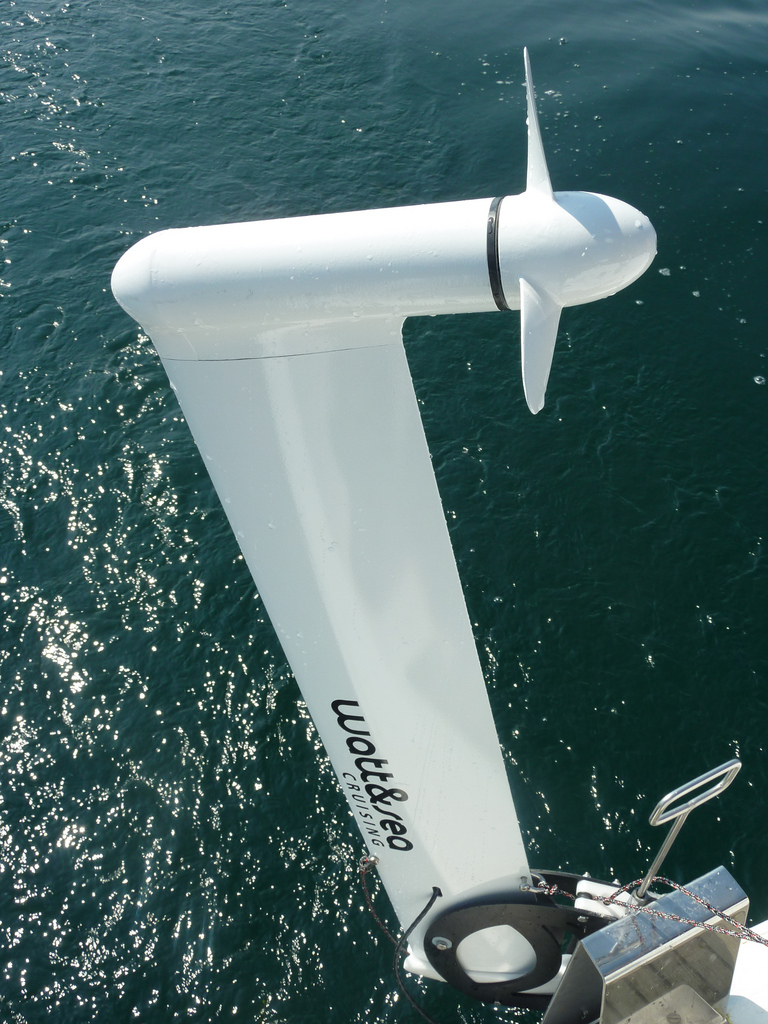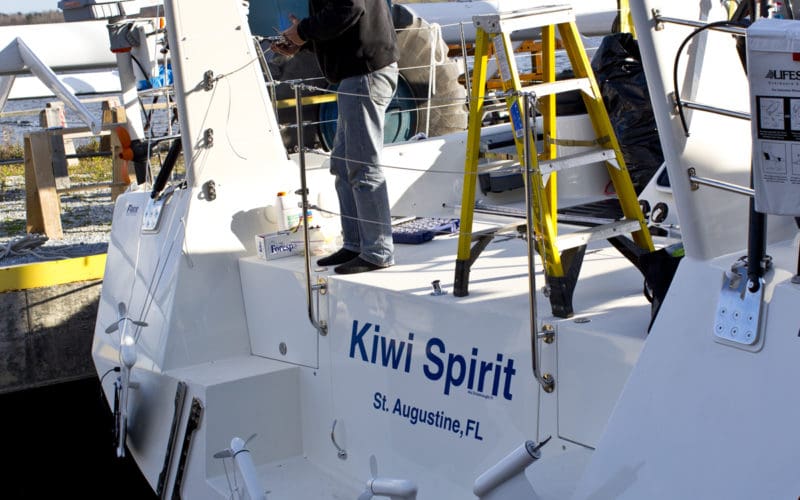Recently, Lyman-Morse launched a 63-foot custom sailboat called Kiwi Spirit (see “One step closer to the dream” in Chartroom Chatter). The boat is owned by Dr. Stanley Paris, whose goal, at age 76, is to be the oldest man to sail around the world and to do it without using any fossil fuels. To generate electricity for use on Kiwi Spirit, Paris will employ solar, wind and water power.
Using water power is the most intriguing part, because water generators, or hydrogenerators, have been an approach less frequently utilized by voyaging sailors. Kiwi Spirit, however, will use a new water generator product called Watt&Sea that just might make hydrogenerators more popular with voyagers.
Watt&Sea was developed by French solo offshore sailor Yannick Bestaven, who won the 2011 Jacques Vabre aboard his Open 40 Aquarelle. The product resembles a long shaft outboard motor but without the engine on top. Instead, Watt&Sea has a generator unit at the bottom of the leg that produces electricity as the boat moves through the water. Kiwi Spirit is equipped with not one but four Watt&Sea units spaced out on the transom so as to provide power no matter the tack or amount of heel.
 |
|
A Watt&Sea hydrogenerator rotated into the up position. |
It makes sense to take advantage of all that water flowing past the hull. Since seawater is about 827 times denser than air, water flow can do more work in a given time than air. So, a hydrogenerator seems the perfect solution to making electricity while voyaging. If that’s so, why have wind and solar been more popular than water generators?
One reason for this may be the type of hydrogenerator products available. Most have been units that use a prop/spinner that is trailed behind the boat like a taffrail log. As the prop/spinner turns in the water flow, it turns the torque line which spins the generator. The generator unit is generally mounted on the stern. This setup requires deploying the spinner, and sometimes retrieving it could be fouled by seaweed or trash in the water. And there is always the chance that spinners can be lost to fish strikes, impacts with heavy objects in the water, etc.
Still, this type of trailing spinner hydrogenerator, like the Ferris Waterpower 200, can make a substantial amount of power. The output curve for the Waterpower 200 claims nearly 20 amps at eight knots of boat speed.
Because the generator unit itself is a cylinder mounted in a bracket on the stern, the Ferris Waterpower 200 can also be fitted with an air blade and hoisted into the rigging to be used as a wind generator. This type of flexibility allows voyagers to continue to make electricity even while at anchor.
The Watt&Sea unit is designed for water only and can’t be used as a wind generator. One big plus for the Watt&Sea, however, is ease of deployment. The generating unit is mounted at the end of a fin-like aluminum strut (in either 38- or 24-inch lengths for the cruising model). The strut is attached to the mounting bracket with a pin. The entire unit can rotate on the pin and be spun up out of the water. So, deploying the Watt&Sea is a little bit like pushing the rudder down on a Sunfish sailboat. Once down, the unit is fully immersed in the water stream. Since the propeller is well below the water surface, it is less likely to be fouled by seaweed or other trash. The strut can still suffer damage from heavier, floating flotsam like logs, however.
Fitted with a standard 9.5-inch propeller, the reported output of the Watt&Sea unit is impressive. At eight knots of boat speed, the unit can produce 200 watts (approximately 16 amps at 12 volts). With the larger 11-inch propeller, output can reportedly reach as high as 400 watts (33 amps at 12 volts) at eight knots. Larger boats that can maintain higher speeds through the water should be able to do even better.
The Watt&Sea also comes in a racing model that has a hydraulically controlled variable pitch propeller. All the race boats in the current Vendée Globe Race are equipped with Watt&Sea racing systems.
A similar type of hydrogenerator, the Aquair UW is offered by Ampair (available from Solar Power Marine: www.solarpowermarine.com), although its electrical output is not as high as the Watt&Sea units.
For some voyagers, one drawback to the Watt&Sea product could be the price. The cruising models have a suggested retail price of $5,995 for the cruising package (includes the generator, strut, 12-volt converter, three-bladed propeller, bracket and fasteners). Compare that to the Ferris 200, which has a cost of $1,899. The Watt&Sea racing version has a suggested price of $18,899. Watt&Sea products are available in the U.S. via eMarine Systems (www.emarineinc.com).
Paris, owner of Kiwi Spirit, will be putting the Watt&Sea units to the test when he undertakes his circumnavigation. His use of these units on his trip and the experience of the Vendée Globe racers will provide useful feedback on the reliability and utility of this product.

